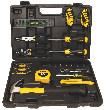Installing a Pop-Up Drain
Written by Lee Wyatt (last updated May 4, 2020)
Have you ever noticed how some bathroom sinks will have a pop-up drain, while others do not? Pop-up drains are great since even the littlest of children are able to use them with little or no teaching. If you do not already have a pop-up drain in your bathroom sink don't worry. Installing a pop-up drain only takes about an hour of your time if you are a complete novice. In fact, this is a wonderful introductory plumbing project that you can use to get your feet wet (figuratively speaking, that is).
This article describes how to install a pop-up drain into a sink that does not already have a drain in place. If you already have a drain attached to your sink, you will need to remove the existing drain pipes and attachments before starting this process.
Materials:
- Water pump pliers
- Plastic putty knife
- Rag
- Pop-up drain kit
- Plumber's putty
- Teflon tape
- Silicone caulk
- 2 inch by 4 inch wood support (long enough to hold up your sink)
Procedure:
- Prep the work area. A bathroom is normally a pretty tight area, and when working in it, it only get's smaller. Remove anything that you do not need from the work area. This means all linens, cleaners, toilet papers, and so on.
- Put the putty on. If you are using a wall hung sink then you need to place your 2 inch by 4 inch wood support under your sink, just off of center. The best location would be about three or four inches away from the drain pipes. Cover the bottom of the drain flange, which looks like a angled ring, with a thin rope of putty.
- Assemble the lock nut and the drain body. Thread the drain body with the lock nut, and then add the friction washer and beveled gasket. The friction washer and beveled gasket are white and black colored respectively.
- Install the drain body. Push the drain unit body up through the bottom of the sink.
- Hand-tighten. Hand-tighten the drain body by turning both the drain body and the flange to ensure that you have a tight connection. Ensure that you only hand-tighten, and that everything is lined up with the linkage.
- Install plunger. Slide the plunger into the opening of drain.
- Insert into opening. Beneath the sink, insert the ball into the opening of the drain tail piece.
- Thread ball-nut. Slide the threaded ball nut over the arm, and screw it onto the drain tailpiece. Only tighten the nut hand-tight.
- Set pop-up arm. Slide the ball arm through the nearest hole in the lever strap, and then hold it in place by fastening a clip. Connect the trap, and then adjust the arm as necessary before finishing.
Author Bio
Lee Wyatt
Contributor of numerous Tips.Net articles, Lee Wyatt is quickly becoming a regular "Jack of all trades." He is currently an independent contractor specializing in writing and editing. Contact him today for all of your writing and editing needs! Click here to contact. Learn more about Lee...
Pet Adoption
Pet adoption is as serious of a process as adopting any member of your family. It is also the best way to go when looking ...
Discover More
Choosing a Professional Organizer
If you find yourself in a state of disorganized chaos, then the services of a professional organizer can be exactly what ...
Discover More
Clutter Control
Whether you have the holidays coming up, or you simply want to have an organized home, clutter control is an important ...
Discover More
More Home Improvement Tips
How Do You Stop Water Hammering?
Water hammering is an incredibly common problem that many, if not most, homeowners will face at least once in their ...
Discover More
Adjusting the Water Heater Temperature
One of the easiest, though slightly annoying, jobs that you can do around the home is adjusting the temperature of your ...
Discover More
Adjusting the Water Level of a Toilet
Knowing the correct way for adjusting the water level of a toilet can help you in a surprising number of ways. Whether ...
Discover More

Comments